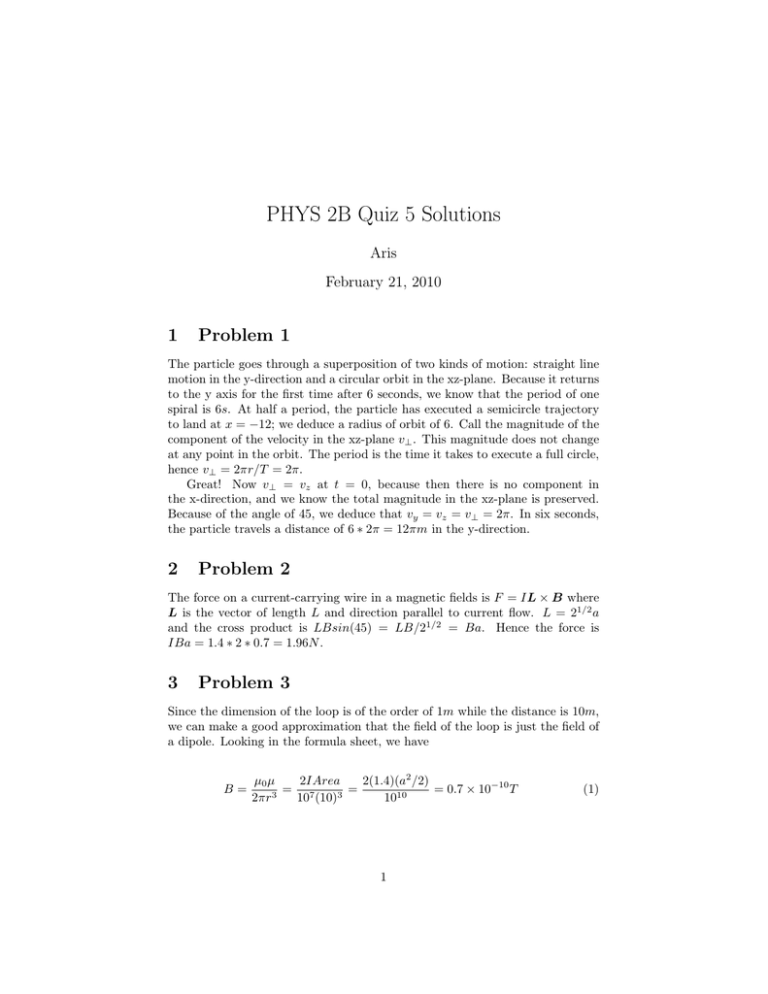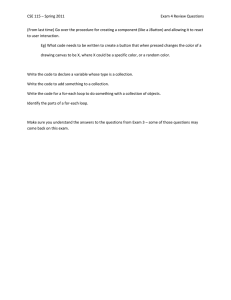PHYS 2B Quiz 5 Solutions 1 Problem 1 Aris
advertisement

PHYS 2B Quiz 5 Solutions Aris February 21, 2010 1 Problem 1 The particle goes through a superposition of two kinds of motion: straight line motion in the y-direction and a circular orbit in the xz-plane. Because it returns to the y axis for the first time after 6 seconds, we know that the period of one spiral is 6s. At half a period, the particle has executed a semicircle trajectory to land at x = −12; we deduce a radius of orbit of 6. Call the magnitude of the component of the velocity in the xz-plane v⊥ . This magnitude does not change at any point in the orbit. The period is the time it takes to execute a full circle, hence v⊥ = 2πr/T = 2π. Great! Now v⊥ = vz at t = 0, because then there is no component in the x-direction, and we know the total magnitude in the xz-plane is preserved. Because of the angle of 45, we deduce that vy = vz = v⊥ = 2π. In six seconds, the particle travels a distance of 6 ∗ 2π = 12πm in the y-direction. 2 Problem 2 The force on a current-carrying wire in a magnetic fields is F = IL × B where L is the vector of length L and direction parallel to current flow. L = 21/2 a and the cross product is LBsin(45) = LB/21/2 = Ba. Hence the force is IBa = 1.4 ∗ 2 ∗ 0.7 = 1.96N . 3 Problem 3 Since the dimension of the loop is of the order of 1m while the distance is 10m, we can make a good approximation that the field of the loop is just the field of a dipole. Looking in the formula sheet, we have B= µ0 µ 2IArea 2(1.4)(a2 /2) = = = 0.7 × 10−10 T 2πr3 107 (10)3 1010 1 (1) 4 Problem 4 We want to superpose magnetic field lines that go in circles around each of the wires. Use the right-hand rule to determine the direction of the field. Call the direction from P to the 2I current x and the direction from P to the I-outgoing current y. I-outgoing contributes one arrow in x; I-incoming contributes 1 in x; 4I contributes 4 in y; 2I contributes 2 in −y. The net result is 2 arrows each in x and y. Superpose them to get a net arrow in the up direction. 5 Problem 5 The magnetic field at the center of a circular loop of radius r is µ0 I/2r. The key point is this: each infinitesimal element on that loop contributes to the field the same amount that every other element does. How do we know this? From the Biot-Savart law, we have dB ∼ (dl × r̂)/r2 . Each element is equidistant to the center of the loop, hence the denominator is the same for all. dl × r̂ is the same for all too, because it always points in the ẑ direction (axis of the loop), no matter which part of the loop you pick. We can now deduce that: if every element contributes the same amount, then the field is proportional to the number of elements. In particular, the field for one quarter a loop is just one quarter the field for a full loop. The net field from the two quarter-loops is just 1/4 ∗ (µ0 I/2a − µ0 I/2(2a)) = µ0 I/16a. The straight length loops make zero contribution to the field. From BS law, we know that dl × r̂ is zero always; dl is either antiparallel or parallel to r̂, hence the cross product is proportional to either sin180 = 0 or sin0 = 0. 6 Problem 6 The infinitesimal force on an infinitesimal current-carrying wire is dF = Idl × B. Here B(l) = µ0 I1 /2πl, and the current element dl is always perpendicular to B, hence the cross product is just the product of the magnitudes: dF = Idlµ0 I1 /2πl. Now we sum all the forces due to each element by integration F = 7 µ0 II1 2π Z 2a dl a 1 µ0 II1 ln(2) = = 0.11µ0 II1 l 2π (2) Problem 7 We need to determine the current density j based on the field given at P1 . Use a rectangular Amperean loop: the two horizontal lengths lie 1cm above the bottom surface and 1cm below the top surface. The length of the horizontal section is arbitrary; call it L. The fields are everywhere horizontal, R hence the vertical lengths of the loop make no contribution to the integral B · dl. (dl 2 is perpendicular to B hence the dot product is zero.) The cross-sectional area enclosed by the loop is 2L. I B · dl = µ0 Ienc (3) BL + (−B)(−L) = µ0 j2L B 2 j= = µ0 µ0 (4) (5) Now use a different Amperean loop that touches P2 . Use a rectangular loop with the horizontal sides 2cm above the top and 2cm below the bottom surface. Once again, the horizontal length is arbitrary. Now the area enclosed is 4L. I B · dl = µ0 Ienc BL + (−B)(−L) = µ0 ( 8 2 )4L µ0 B=4 (6) (7) (8) Problem 8 What is your Amperean loop here? You are given (nearly) half of it. The other half is another 22m-long horizontal line segment just above the wires. Close off the ends of the two horizontal lines at x = 0, 22. We say that the vertical sides make little contribution to the integral because they’re so small! By up-down symmetry, the contributions of both top and bottom horizontal lines are equal. I B · dl = µ0 Ienc (9) 10−5 + 10−5 = 4π10−7 ∗ (8I) 200 200 ≈ =2 I= 32π 100 (10) 3 (11)




